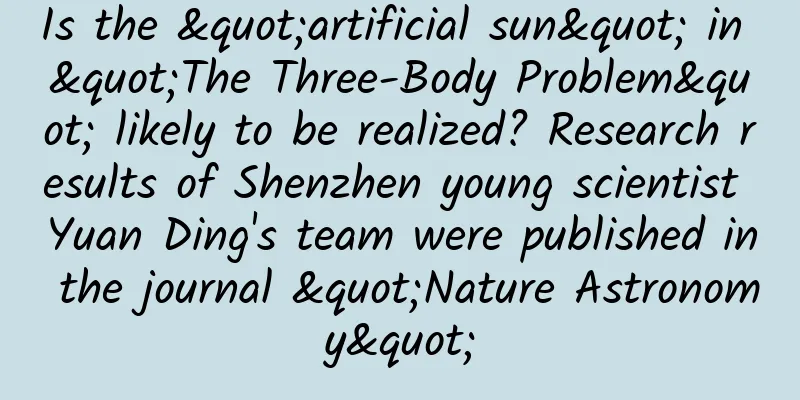Is the "artificial sun" in "The Three-Body Problem" likely to be realized? Research results of Shenzhen young scientist Yuan Ding's team were published in the journal "Nature Astronomy"

|
For 5,000 years, Chinese civilization has been exploring astronomy. Ancient Chinese books such as the Book of Changes and the Book of Han contain the earliest and most systematic records of the sunspot world in the sun. Today, Professor Feng Xueshang and Associate Professor Yuan Ding of the Institute of Space Science and Applied Technology of Harbin Institute of Technology (Shenzhen) have proposed an innovative physical mechanism of solar plasma heating using the world's largest solar telescope and high-performance computer simulation methods to address the "solar corona heating problem", and Chinese research on the sun has taken another step forward. Screenshot of the inside page of the magazine Nature Astronomy On May 25, the results were published in Nature Astronomy under the title of "Transverse Oscillations and Energy Source in a Strongly Magnetized Sunspot". Associate Professor Yuan Ding of Harbin Institute of Technology (Shenzhen) was the first and corresponding author, Master's student Fu Libo was the second author, Professor Feng Xueshang and postdoctoral fellow Blazej Kuzma were co-authors. Reporters learned that this research brought together the joint efforts of scientists and research institutions in Europe, the United States and other countries. As the initiators of the project, Professor Feng Xueshang and Associate Professor Yuan Ding of the Institute of Space Science and Applied Technology of Harbin Institute of Technology (Shenzhen) took on the work of "chief designer" to help mankind understand the sun to a new level. The “coronal heating problem” is of great significance The "China Lunar Exploration Project" has successfully brought back lunar soil from the moon. The moon is getting "closer", so what about the sun? Yuan Ding, associate professor at the Institute of Space Science and Applied Technology of Harbin Institute of Technology (Shenzhen), told reporters that human research on the sun is still in the "primary stage". "At this stage, our research on the sun mainly serves the fields of aerospace, communications and navigation. With the development of the digital economy, humans have more and more assets in space, such as space satellites, space stations, and lunar (Mars) bases, accompanied by a huge digital economy industry chain. The activities of the sun directly threaten human space assets. If a solar storm hits and the power grid or communication system is damaged, we will face a life without electricity, communications, the Internet and social media." The umbra fibers in sunspots oscillate laterally in strong magnetic regions, carrying huge amounts of energy. The sun is a gas ball composed of hydrogen, and its energy comes from nuclear fusion reactions inside the sun. Energy is transmitted from the inside to the outside, from the sun's core to the sun's surface (photosphere), and the temperature drops from more than 16 million degrees Celsius to more than 5,000 degrees Celsius. The corona is outside the photosphere, farther from the heat source in the core, and its temperature should be lower. However, the actual temperature of the corona is as high as millions of degrees Celsius, 1,000-10,000 times higher than the photosphere. This is the problem that has plagued the physics community for a century - the solar corona heating problem. The solar corona heating problem is a "prominent subject" in the field of solar research, and was selected by SCIENCE magazine in 2012 as one of the eight unsolved mysteries of contemporary astronomy. Yuan Ding, Associate Professor of the Institute of Space Science and Applied Technology, Harbin Institute of Technology (Shenzhen) Yuan Ding studied optical information science and technology at Harbin Institute of Technology as an undergraduate, obtained a master's degree in nuclear engineering at the Royal Institute of Technology in Sweden, and then obtained a doctorate in physics at the University of Warwick in the UK. The composite and interdisciplinary learning experience laid a solid foundation for his later research in solar physics. In 2017, after completing his studies, Yuan Ding came to Harbin Institute of Technology (Shenzhen) to work on space science and applied technology research. "This is a Nobel Prize-level scientific research topic." Yuan Ding said that he has long been concerned about the problem of coronal heating: Why is the corona so hot? Understanding the principle of coronal heating will promote scientific research related to "artificial suns", and it may no longer be a dream for humans to use safe, clean, efficient and sustainable "artificial sun" energy. In the future world described in the science fiction novel "The Three-Body Problem", humans have created a controllable nuclear fusion device-a "miniature sun" burning in a reactor, which consumes a small amount of fuel to release huge heat for power generation. This device is called an "artificial sun." Good Solar Telescope is a "god assist" There have been many hypotheses, inferences and studies in the scientific community about the issue of coronal heating. Feng Xueshang and Yuan Ding have gone a step further based on the work of their predecessors. In 2018, Yuan Ding went to the Big Bear Lake Observatory in California, USA to conduct astronomical observations, where he found the "god assist" to solve the puzzle - the Gould Solar Telescope. The Gould Solar Telescope has an aperture of 1.6 meters and is the largest solar telescope currently in operation in the world. Its unique observation site and powerful observation instruments and equipment make it possible to overcome this extremely challenging research topic. Using the high temporal and spatial resolution observation data of the Gould Solar Telescope, Yuan Ding discovered that there is periodic transverse motion in the strong magnetic field of sunspots, namely transverse-mode magnetohydrodynamic waves. The 1.6-meter Gould Solar Telescope at the Big Bear Lake Observatory in the United States is the largest solar telescope in the world. Yuan Ding explained that sunspots are the coldest structures on the surface of the sun, with a temperature of about 4,000 degrees Celsius, while the corresponding solar active regions above them are the hottest areas in the solar corona, with a temperature of about 2 to 20 million degrees Celsius. The magnetic field and high-temperature plasma coupling structure composed of sunspots and active regions make the conditions for solar plasma heating more demanding, and these characteristics attracted the attention of the research team. In 2018, when Yuan Ding was conducting astronomical observations at the Big Bear Lake Observatory in California, it coincided with the active cycle of sunspots. He found that the umbra fibers in the sunspots swung horizontally, generating huge energy. "The timing of observation is very important," said Yuan Ding. Opportunity always favors the prepared mind. Through observations, data review, hypothesis proposals and joint research with an international team, we ultimately calculated, based on mathematical modeling, that the driving force required for the strong magnetic regions of sunspots (about 4000 gauss) is 100 to 1000 times higher than that of other areas of the Sun. The energy flow carried by this type of movement is about 7,500,000 watts per square meter. Only one thousandth or one ten-thousandth of the energy is enough to meet the energy flow required to heat the solar corona, which meets the requirements for solar plasma heating. "The lateral movement of the strong magnetic areas of sunspots is equivalent to the lateral swinging of high-rise buildings in the city. This type of movement carries a huge energy flow, and only a strong earthquake can drive this type of movement. From this, it can be imagined that the lateral movement of the strong magnetic fields of sunspots carries very high energy. The team estimates that this energy flow is equivalent to 7,500 air conditioners running at full power to heat an area of 1 square meter." Yuan Ding said. Research results spark heated debate Talking about the significance of the research, Yuan Ding said that the biggest breakthrough of the research is the first detection of a new energy source that is tens of thousands times stronger than the energy flow required for coronal heating, and the use of supercomputer simulation to reproduce the plasma heating effect of this energy source, creating a revolutionary field of coronal heating. This research has the potential to solve the century-old physics problem of coronal heating, and is expected to become a key scientific target for large-scale international scientific research equipment such as the next generation of 4-8 meter aperture solar telescopes. It is understood that after the paper was published, it attracted close attention from the scientific community and the public. Nature magazine invited Marco Stangalini, a famous scientist from the Italian Space Agency, to write a review on this research, evaluating its groundbreaking contribution to the theory of coronal heating and its guiding significance for the construction of large ground-based solar telescopes. More than a dozen internationally renowned media and scientific magazines, including National Geographic, reported on this research. Stills from the TV series "The Three-Body Problem" The study detected a new energy source that is stronger than the energy flow required for coronal heating, which can't help but induce associations - will the "artificial sun" in "The Three-Body Problem" be closer to reality? Yuan Ding said that the results did help promote the development of plasma heating technology for the "artificial sun". Plasma heating is an important step in explaining the source of the solar wind, which provides an important fuel for interstellar travel. "Of course, neither the 'artificial sun' nor 'interstellar travel' is likely to become a reality in the short term, but this research result has laid a very important foundation for subsequent research." Yuan Ding said that the results have pushed the "progress bar" of related scientific research forward one step. Yuan Ding also revealed that the team will continue to focus on scientific research in the field of coronal heating. "The next step is to focus on whether the new energy source of sunspots is common. The goal is to apply this theory to stellar spots and use advanced mathematical modeling and astronomical equipment to explore the plasma heating mechanism of stellar spots." This project was completed by an international team led by Feng Xueshang and Yuan Ding, and the research was supported by experts and scholars around the world: Master student Fu Libo and postdoctoral fellow Blazej Kuzma participated in astronomical data analysis and two-fluid magnetohydrodynamic numerical simulation respectively; Harbin Institute of Technology (Shenzhen) Institute of Space Science and Applied Technology was responsible for astronomical experiment design and astronomical data analysis; New Jersey Institute of Technology (Big Bear Lake Observatory) was responsible for astronomical observations and data calibration of the Goode Solar Telescope; the Canary Islands Institute of Astronomy and Physics in Spain was responsible for Stokes optical inversion and modeling; the School of Physics of Marie Curie University in Poland was responsible for two-fluid magnetohydrodynamic numerical simulation; the Department of Mathematics of KU Leuven in Belgium was responsible for mathematical modeling; the Indian Institute of Technology team participated in astronomical experiment design and paper writing related work; the School of Information Engineering and Automation of Kunming University of Science and Technology, Shenzhen Information Vocational and Technical College, and the National Astronomical Observatory participated in astronomical data analysis and other related work. 【Harbin Institute of Technology (Shenzhen) Institute of Space Science and Applied Technology】 |
>>: Isn’t it really a waste of money to spend so much money on protecting wildlife?
Recommend
Samsung S5 screen test
Bulgarian website Smartphone.bg praised the Galaxy...
Apple isn't at CES, but HomeKit is everywhere
[[125938]] The smart home market is very hot now,...
「Dry Goods」22 Micro-Marketing Practical Tips You Don’t Know!
Now many individuals and companies are playing wi...
What pitfalls should products and operations avoid?
We can’t copy other people’s successful experienc...
Asian Winter Science Popularization Issue 17丨Deciphering why the body needs to tilt when turning in speed skating?
First instance: Yu Qun Second trial: Suo Yingxing...
The fierce competition between the two brightest minds made the chemical bond theory compatible [Part 1]
How atoms connect to form molecules is the primar...
When you think of the deep sea, you think of the legendary "giant monster"? There are actually quite a few "prototypes" in reality!
Leviathan Press: To this day, the scientific comm...
Why has JavaScript become the first choice for many mini-programs?
[[256303]] Since Baidu first proposed the concept...
Aren’t non-woven bags used for takeout considered eco-friendly bags? They are also “plastic bags”?
Now, if you buy vegetables online, you can get a ...
What are the functions of the outbound travel mini program? How much does it cost to make an entry and exit mini program?
With the continuous development of China's ec...
iPhone 7 data is inexplicably lost. Why is Apple's frequent problems caused by this?
Apple has been having a hard time recently. The i...
Advice from an old programmer: Don’t rely on technology for your whole life
[[225216]] I am doing it myself now, but I have b...
Can eating chili peppers speed up the recovery of oral ulcers?
Recently, some netizens claimed that if you want ...
Google's attitude towards controllers is so "ruthless". Is there still hope for Android TV games?
A smooth gaming experience is inseparable from ex...
AiKop | "Cats" on the big ship
One, two, three...prepare to sing Let's learn...









